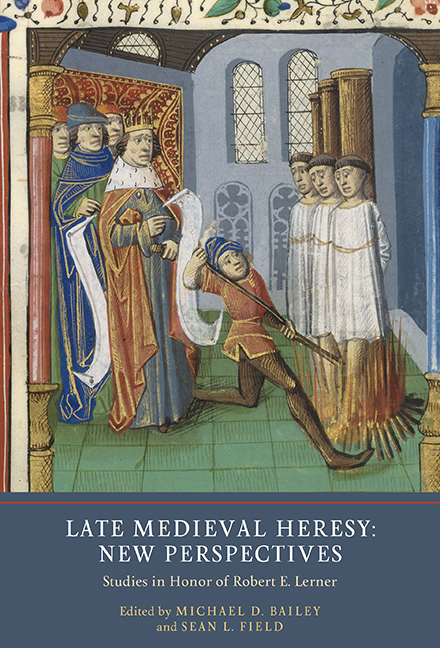Book contents
- Frontmatter
- Contents
- Preface: Robert E. Lerner: A Portrait
- List of Contributors
- Introduction: Historiography, Methodology, and Manuscripts: Robert E. Lerner and the Study of Late Medieval Heresy
- 1 The Heresy of the Templars and the Dream of a French Inquisition
- 2 The Dissemination of Barthélemy Sicard's Postilla super Danielem
- 3 Magic, Mysticism, and Heresy in the Early Fourteenth Century
- 4 The Making of a Heretic: Pope John XXII's Campaign against Louis of Bavaria
- 5 Unusual Choices: The Unique Heresy of Limoux Negre
- 6 Princely Poverty: Louis of Durazzo, Dynastic Politics, and Heresy in Fourteenth-Century Naples
- 7 Disentangling Heretics, Jews, and Muslims: Imagining Infidels in Late Medieval Pastoral Manuals
- 8 New Frontiers in the Late Medieval Reception of a Heretical Text: The Implications of Two New Latin Copies of Marguerite Porete's Mirror of Simple Souls
- 9 Disputing Prophetic Thought: The 1466 Questio quodlibetalis of Johannes of Dorsten
- 10 Heretics, Allies, Exemplary Christians: Latin Views of Ethiopian Orthodox in the Late Middle Ages
- 11 ‘By them in reality I meant the Jews’: Medieval Heretics in the Work and Life of Renate Riemeck (1920–2003)
- Afterword: Who or What Was a Heretic in the Late Middle Ages?
- Robert E. Lerner: A Chronological Bibliography
- Index
- York Medieval Press: Publications
3 - Magic, Mysticism, and Heresy in the Early Fourteenth Century
Published online by Cambridge University Press: 14 June 2019
- Frontmatter
- Contents
- Preface: Robert E. Lerner: A Portrait
- List of Contributors
- Introduction: Historiography, Methodology, and Manuscripts: Robert E. Lerner and the Study of Late Medieval Heresy
- 1 The Heresy of the Templars and the Dream of a French Inquisition
- 2 The Dissemination of Barthélemy Sicard's Postilla super Danielem
- 3 Magic, Mysticism, and Heresy in the Early Fourteenth Century
- 4 The Making of a Heretic: Pope John XXII's Campaign against Louis of Bavaria
- 5 Unusual Choices: The Unique Heresy of Limoux Negre
- 6 Princely Poverty: Louis of Durazzo, Dynastic Politics, and Heresy in Fourteenth-Century Naples
- 7 Disentangling Heretics, Jews, and Muslims: Imagining Infidels in Late Medieval Pastoral Manuals
- 8 New Frontiers in the Late Medieval Reception of a Heretical Text: The Implications of Two New Latin Copies of Marguerite Porete's Mirror of Simple Souls
- 9 Disputing Prophetic Thought: The 1466 Questio quodlibetalis of Johannes of Dorsten
- 10 Heretics, Allies, Exemplary Christians: Latin Views of Ethiopian Orthodox in the Late Middle Ages
- 11 ‘By them in reality I meant the Jews’: Medieval Heretics in the Work and Life of Renate Riemeck (1920–2003)
- Afterword: Who or What Was a Heretic in the Late Middle Ages?
- Robert E. Lerner: A Chronological Bibliography
- Index
- York Medieval Press: Publications
Summary
The late medieval period began with one vast, imagined heretical conspiracy and ended with another. The Clementine decree Ad nostrum, drafted at the Council of Vienne in 1312 and finally promulgated by John XXII in 1317, was ‘the birth certificate of the heresy of the Free Spirit’. Almost two centuries later, the infamous Malleus maleficarum (1486) marked the culmination of medieval thought on diabolical witchcraft. At the level of pure stereotype, the similarity between the antinomian heretics for whom sex was not a sin and the malevolent sorcerers who would fornicate with demons at unholy sabbaths is evident. We now know, however, that the reality behind the supposed Free Spirit movement actually lay in the ‘late medieval search for God and godliness’ and was ‘closely related to the orthodox mystical movement’ of the period. The reality of witchcraft, on the other hand, lay mostly in the mundane world of practical magical rites used by ordinary people or especially adept cunning-folk. This may explain why the most recent connection drawn between the heresy of the Free Spirit and witchcraft has focused on mechanisms of prosecution rather than the essence of each heretical system.
Here I will pursue a different tack. Instead of looking at inquisitorial structures or the often standardized cache of charges lodged against heretics, I will seek to expose more fundamental similarities between magical rites and mystical reverie. In particular, I will argue that these seemingly disparate practices aroused essentially similar concerns among clerical authorities in the late Middle Ages. To do so, I will turn to the early fourteenth century and explore two specific examples, first of unorthodox mysticism and then of condemned magic. Both are idiosyncratic in many ways, but they also illustrate important trends. My mystic needs no introduction: Marguerite Porete, burned in Paris in 1310, and a formative figure, at least in the minds of clerical authorities, for the heresy of the Free Spirit. My magician is much less famous: John of Morigny, a Benedictine monk and author of a sprawling work of visionary rituals. His treatise was attacked by other clerics in 1315 and was burned in Paris in 1323.
- Type
- Chapter
- Information
- Late Medieval Heresy: New PerspectivesStudies in Honor of Robert E. Lerner, pp. 56 - 75Publisher: Boydell & BrewerPrint publication year: 2018



